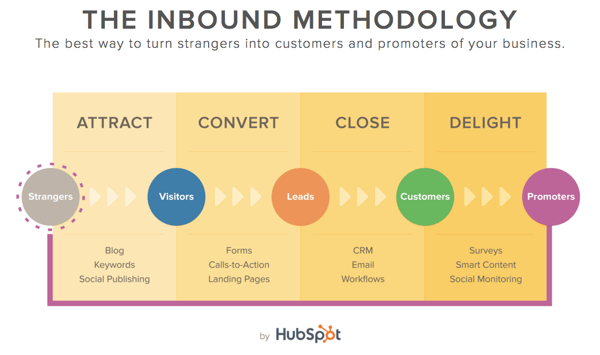
Startups that are just starting out with business activities like Marketing have one main challenge: to launch and scale their business in the most efficient way possible. To achieve this, defining the marketing strategies that your business will use is a fundamental step.
In recent years, Marketing strategy for startups has focused on Digital Marketing tools, which make it easier for brands to obtain greater visibility and that are economically viable. With the right strategy, it's possible to use a wide variety of Digital Marketing and Inbound Marketing actions that are appropriate for your small business in terms of timing, resources, and investment. Below, we share the 8 essential Marketing strategies your startup should be using.
1. Clear brand definition and differentiation
These are the first steps you should take with your startup strategy. Having both aspects clear will allow you to make all kinds of decisions regarding your brand focus, and do so in the most beneficial way for your company.
1.1. Clear definition of vision/branding for Marketing
 Knowing your vision will allow you to establish the goals you want to reach in the long term and avoid any uncertainty along the way. To make your vision as effective as possible, Simon Sinek, one of the keynote speakers for TED Talks, explains in this video that the vision must be based on the question "why" in order to be as successful as possible.
Knowing your vision will allow you to establish the goals you want to reach in the long term and avoid any uncertainty along the way. To make your vision as effective as possible, Simon Sinek, one of the keynote speakers for TED Talks, explains in this video that the vision must be based on the question "why" in order to be as successful as possible.
In the case of startups, it is essential to work on everything surrounding your brand: logo, mission, corporate identity, etc. You should have previously studied what you want your products or services to offer people, and that goes beyond covering a need.
For example, when speaking about Apple, it's not just the characteristics of its world-famous products that matter, but also the feeling of belonging to the brand that goes along with being a user of Apple products.
1.2. Differentiation in the market
If you want your company to stand out from the competition, differentiation in the market is fundamental. For this, you have to know what you can offer buyers that other companies cannot (a better price, higher quality of your products/services, etc.). and position yourself appropriately in the market.
2. Marketing Plan + Platforms
2.1. Marketing Plan
Today's market is constantly changing. When making a marketing plan, you must not only take into account the traditional aspects of businesses (SWOT, KPIs, etc.), but also focus on new channels that have more weight in the modern business environment (social media, apps, etc.) According to Urbaniza, 60% of people hear about a product for the first time on Instagram and 75% visit the company's website after seeing a post about it.
2.2. Marketing Platforms
 To carry out all the necessary operations for your startup, from Marketing to lead generation to sales, there are different platforms that can help you. HubSpot is, without a doubt, the best Inbound Marketing platform on the market, but there are a great variety of options including Pardot, Marketo, WordPress, Rock Studio, Contently, Coobis, and more depending on the functionality you're looking for.
To carry out all the necessary operations for your startup, from Marketing to lead generation to sales, there are different platforms that can help you. HubSpot is, without a doubt, the best Inbound Marketing platform on the market, but there are a great variety of options including Pardot, Marketo, WordPress, Rock Studio, Contently, Coobis, and more depending on the functionality you're looking for.
In general, all of these platforms and apps centralize and streamline your Marketing tasks like content creation, lead management, SEO optimization, etc. The platform you choose is of great importance; In fact, 80% of marketers credit their success to marketing automation. Be sure to weigh all the pros and cons, get a demo, and get an expert opinion.
3. Website + Blog
3.1. Website
For your startup's website, we recommend making it as attractive as possible based on your target audience.
- Use a font and colors that define your brand at the first glance.
- Make your website very intuitive so that visitors can quickly and easily find what they are looking for.
- It is also important that your website loads as soon as possible, thus avoiding losing 7% of conversions, according to Infront Webworks.
3.2. Blog
A very important aspect of your online presence is your blog. We recommend that you follow these key steps:
- Create specific Buyer Personas for each blog post that you write.
- Center each post around one specific topic, so that reader instantly knows the blog's main message.
- Use a tone that your audience will understand, avoid jargon.
- Include relevant posts on your blog and another website, which will help improve your search engine rankings and increase your organic traffic by up to 26%, according to BP Studios.
3.3. Landing Pages
If you aren't planning on using landing pages in your strategy, you'd be making a serious mistake. Landing pages can help grow your leads 55% by simply increasing the number of landing pages, according to HubSpot's study of 7,000 businesses. And using videos on your landing pages will allow you to get 86% more conversions, according to Wordstream. Your landings can never be without an attractive title, a CTA, a form, and specific, useful information.
3.4. Conversion
For conversion, Inbound Marketing is your number one ally. Via the Inbound method, you'll create specific content for specific prospects, therefore attracting more relevant and qualified buyers.
It is important to be very detailed and precise when leading visitors through the different stages of the Buyer's Journey. You must be aware of every element of the conversion process and optimize your strategy by doing A/B testing to see what works best. Be aware what each stage of the process involves and the appropriate formats and content for each stage.

4. Search Engine Optimization Strategies
SEO is key to achieving good organic positioning that generates traffic and authority for your startup. In fact, according to Ahrefs, companies that have used SEO strategies for more than two years charge 275% more for projects than those that haven't used SEO. So what SEO actions can you use?
4.1. Pillars Pages + Topic Clusters
The Inbound methodology has led to the emergence of concepts such as pillar pages and topic clusters, but what exactly are they?
Pillar pages and topic clusters are the stars of HubSpot's content strategy. A topic cluster is a way to structure all the blog posts and pages of a website around a main topic, which serves as the pillar page. For a pillar page to be efficient, it must explain a broad, but pivotal business topic in-depth, with related blog posts making up the topic cluster that links back to the main pillar. Through this strategy of establishing linking between related posts, you will cause your pillar to obtain authority and rise in the search rankings.
4.2. Keywords/Content Optimization
The use of keywords is one of the most common and successful SEO strategies out there. Doing in-depth keyword research will help you pinpoint the topics you can address in your sector and avoid the competition. Knowing your audience's search habits is also extremely insightful for your business. All this will help you optimize your content, but you must also do other things such as:
- Quality and frequency:Content Marketing isn't about writing the most posts possible, but about producing high-quality and consistent content. As a good rule of thumb, publishing 4-6 blog posts per month is a good amount.
- Link-building: Include links to relevant internal content (blog posts, landing pages, product pages) and to external websites that are reputable and have authority.
- Video Marketing: Video is currently one of the most-consumed formats, so including Video Marketing in your strategy will make your posts stand out and your engagement grow.
5. Email Marketing + Lead Nurturing
5.1. Newsletters
Not long ago, newsletters seemed like an old-fashioned concept, however, this email marketing trend is hotter than ever. Today, a newsletter will allow you to create and maintain customer relationships at a low cost. To make your newsletters a success, pay careful attention to segmentation and personalization, and make sure to generate familiarity and authority with the content you choose.
5.2. Follow up emails
According to VenzoCRM, only 2 out of 100 sales are closed after a meeting, so you need to have a follow-up strategyin order to get that number higher. The answer is follow-up emails. Each email should be extremely personalized and focus on the information and result you want to obtain. For example, you could say thanks for the meeting, list the next steps, ask for a response, request another meeting, etc. If you don't receive any response, consider a second follow-up email and after any deal, always send a thank you email.
5.3. Lead Nurturing
Incorporating lead nurturing into your digital strategy will help you get more information about your users, detect new business opportunities, convert potential customers, and more! Lead nurturing is usually an automated email process that gives relevant information to users in the right place, at the right time. It leads them through the stages of the Marketing and Sales funnel. Discover tips for successful lead nurturing:

- Automate the processwith workflows based on database segmentation and contacts' history and actions.
- In theawareness stage, you want to offer educational information about their problem or need. You must show immediate value and let them know how/where they can gain further information (CTA, landing page, sign up, etc.)
- In the consideration stage, gated content and webinars can be used to gain their details and give them more in-depth information on your company, products, and services.
- Finally, in the decision stage, more commercial content can be used to close the sale, including testimonials, demos, personalized assessments, promotions, etc. Sales agents should be heavily involved at this point.
6. Social Media Posts and Promotion
6.1. Social Media Setup
First of all, you have to set up your brand's accounts on various social network, but it's not necessary to choose all of them. Study which social channels work for your audience and how you can uniquely position yourself. This will involve studying your Buyer Personas, their age, demographics, behaviors, etc. and matching that to an appropriate social network.
6.2. Organic Posts
Organic content is becoming increasingly important in social networks. It's what helps you establish a relationship with your followers and guides your brand presence and perception. In order for your organic posts to be effective in maintaining engagement and conversations with your followers, your publications must encourage them to engage. Ask questions and ask your followers their opinion, and use interactive content like games, polls, quizzes, live video, etc.
6.3. Snack Content
Snack content is specially designed for digital media and its main objective is to be easily consumed and shared. Common characteristics include a short format, creative and visual style, and the use of different formats like videos, images, quotes, gifs, animations, etc. Think Instagram Stories, TikTok videos, or Snapchat. Use of short-form images or videos obtains 94% more visits according to a study carried out by MDG Advertising, while SEOmoz says posts with video are 3 times more shared than those that only contain text.
6.4. Influencers
Influencers can help brands in many ways: for the launch of a new product or service, events, awareness, promoting new campaigns or initiatives, etc. If your budget allows and it is relevant for your business, we recommend you investigate potential micro-influencers in your sector and factor them into your strategy. The director of Adidas says that 70% of their brand engagement comes from working with influencers.
6.5. User-Generated Content (UGC)

User generated content is as its name suggests: content about your company created and posted by your online followers. Controlling this valuable content stream isn't easy, but there are ways to go about it:
- Generate a community by getting your followers involved and engaged with your brand as much as possible.
- Give visibility and feedback to users who post positive content about your brand. Reshare, comment, give them perks, etc.
- Try your best to answer all posts, positive and negative.
- Choose brand ambassadors and facilitate images, videos, and messages you want them to spread, in return for certain benefits. It doesn't necessarily have to be a paid/financial incentive. Followers have different motivations, find out what yours are motivated by!
7. Paid Media
7.1. Google Ads
- Google Display: Google has three ways to do online advertising and Display is the first. These text+graphics ads reach more than 80% of Internet users worldwide, in more than 30 languages, in 100 countries. Before doing a Display campaign, you should consider how much you want to spend, the number of ads you want to promote, and which keywords you can use.
- Google Search: This type of advertising is mainly focused on paid web positioning for relevant searches. With Google Search, you can manage your presence on the Google rankings, carry out an internal and external link analysis, detect problems in your website, etc. This combined with organic SEO is a great way to attract new leads.
- Google for Video: With the popularity of videos, Google has developed options for video advertising either for video ads in YouTube search results or before, during and after videos on YouTube/Google Display Network.
A combination of these three types of paid ads can help you reach your intended audience, expand brand awareness and lead generation, and influence your bottom line. However, Google Ads is an extremely specific tool, and you need to count on an expert to help manage your strategy and budget.
7.2. Facebook Ads
This type of advertising will allow you to have high levels of segmentation, measure results, interact with users, etc. Our advice for Facebook Ads is to carry out retargeting campaigns, since you will be able to recover abandoned carts, which is one of the big problems of ecommerce. You should also install the conversion pixel to know the behavior of your users and track them. This is very useful for measuring ROI.
7.3. LinkedIn Campaigns
LinkedIn is the ideal place for B2B advertising and awareness. This platform has numerous formats that allow you to carry out your strategies, highlighting Native Videos (which have the best completion rates), dynamic ads (ideal for launching more direct and visual messages) and Lead Generation (the best for getting quality leads), InMail direct messages, etc.
7.3. Instagram for E-Commerce
Did you know that 80% of users are influenced by Instagram to buy a product or service (Facebook)? This makes many companies use the application itself as a virtual store. To make your Instagram as useful as possible, we recommend you to show your products or services in action, use hastags, run contests and promotions through the app, and share photos of your products taken by your followers, if available.
8. Partnerships
Partnership agreements that can be made by companies between themselves or by companies with influence can be very beneficial for both parties. Let's go a little deeper into this world.
8.1. Partnerships/sponsorship

While the partnership is to carry out the association of a brand with another or a brand with one or a few influencers, the sponsorship is an agreement between different companies, where one of them is sponsored within the channels of the other.
Partnership agreements can help you provide a more affordable way to reach consumers. If, for example, your sector is the flooring industry, you could get in touch with an architectural influencer who can talk about your products. In this way, you will be able to reach new audiences and unlock new market niches that may be of interest to you.
8.2. Guest blogging
Guest blogging is a very beneficial practice for both parties involved: on the one hand, the guest blogger can give relevant information to your website or social networks and even include links to your blog. On the other hand, that person's blog can attract new users by having new and different content than they typically post. Without a doubt, this tactic is one of the most effective link-building tactics today and will make your SEO much better.
8.3. Link building
This section is directly related to the previous one, and as we have said, guest blogging can help you with link building, although there are other ways to improve it. When creating links, you should take into account the exact content of the page, the position of the link (in the footer, in the header etc.) and the diversity in the domains (the more domains -as long as they are quality domains- the better).
You can generate the link building naturally or manually:
- Natural: it depends 100% on the content you generate. If it is of quality and interesting, people will want to link to it. To achieve this, you can publish computer graphics, generate controversy, publish a tutorial on a topic that you control and that people like, etc.
- Manual: the first thing you have to do is generate and find relevant websites that you want to link to. To do this, you can search in related forums, search with link analysis tools such as "Open Site explorer" the links that your competition has, etc
8.4. Piggybacking
This type of strategy must be carried out with another company and consists of another company allowing you to use its network of contacts to sell your products in exchange for a commission. If you are thinking of doing this, we recommend you reach agreements about commissions, the sales process, and the exclusivity. As for the latter, it is advisable to set up a short-term contract so that, in case you don't get results, you don't have to continue.
Concentrating on a specific Marketing Strategy for startups is the best way to grow your small business. These 8 strategies are just the start. Next comes integrating your sales and service pipelines, automation, database optimization, and more into the process. Contact us for further information

Alexandra Martín
Alexandra is a true Marketing enthusiast. Her aspirations inspired her to leave her native home in the Canary Islands and move to Madrid. She enjoys all the great cultural and professional offerings that this city holds. Alexandra also loves the sea, her dogs, and music.
It may interest you
LATEST
BLOG POSTS
SUBSCRIBE TO MBUDO BLOG
And get your inbound news directly in
your inbox, once a month.

